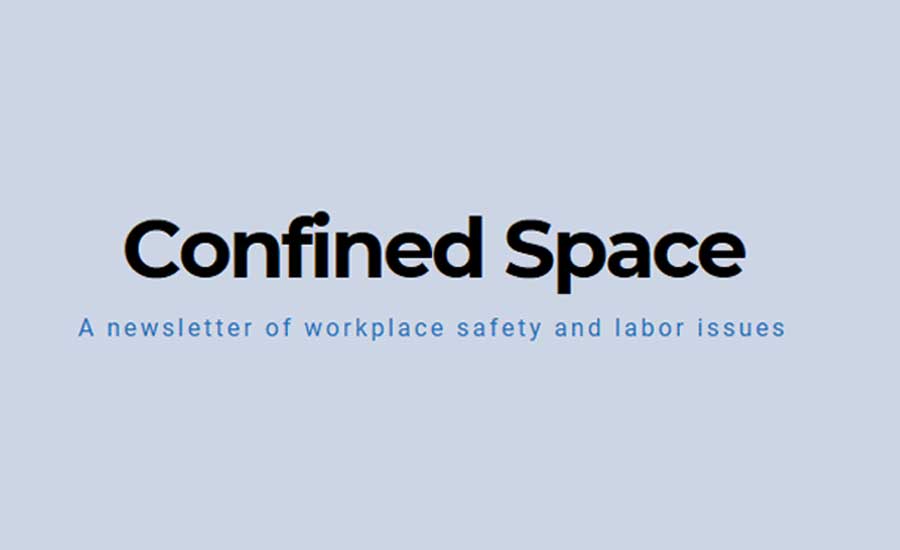A Confined Space blog post
Protecting America’s Workers Act introduced
Would strengthen OSHA and workers’ rights

Posted with permission from Jordan Barab.
A new and improved Protecting America’s Workers Act (PAWA) has been introduced into the House of Representatives by Congressman Joe Courtney (D-CT). Similar versions of this bill has been introduced every year for over a decade. The bill number is H.R.1074 and a copy of it can soon be found here. (In the meantime, here is a PDF and a Section-by-Section analysis.)
As with past PAWA bills, this version, which has 27 co-sponsors, extends OSHA coverage to public sector employees in those states where they’re not currently covered (as well as federal employees), strengthens anti-retaliation protections for workers, requires the abatement of hazards during contests by employers and toughens criminal penalties.
In addition, this year’s bill also includes provisions to codify OSHA’s severe injury and electronic injury reporting requirements (including the detailed reporting by large employers recently withdrawn by OSHA). It reverses the revocation of the “Volks Rule” which was repealed by Congress and the President under the Congressional Review Act at the beginning of the Trump administration.
| PAWA significantly expands workers’ rights to participate in improving health and safety in their workplaces, and enhances the ability of OSHA to effectively enforce safe working conditions. |
The bill significantly expands workers’ rights to participate in improving health and safety in their workplaces, and enhances the ability of OSHA to effectively enforce safe working conditions.
Courtney introduced the bill on the anniversary of the 2010 Kleen Energy power plant explosion that killed 5 workers in Middletown, Connecticut. According to Courtney,
What’s In PAWA?
If passed, PAWA 2019 would:
- Expand OSHA coverage to millions of state and local government employees in the 24 states where they’re not currently covered and broaden OSHA coverage to include federal employees.
- Authorize felony penalties against employers who knowingly commit OSHA violations that result in death or serious bodily injury and extend such penalties to corporate officers and directors. Under the current law, criminal penalties for the willful death of a worker are only misdemeanors. In addition, knowing violations which cause or contribute to the death of a worker would have a maximum fine of $250,000 for individuals and $500,000 for organizations, or a 10-year prison term, or both. Death of a worker would not be the only violation that could send an employer to jail. Knowing violations which cause “serious bodily harm” are subject to maximum fine of $250,000 for individuals and $500,000 for organizations or a 5-year prison term, or both.
- Codify the Susan Harwood Training Grant Program to provide grant funding for training and education programs for workers and employers. President Trump has attempted to eliminate the program in his last two budgets.
- Reinstate the “Volks Rule,” making it an employer’s ongoing obligation to maintain accurate records of work-related illness and injuries. This reverses a Congressional Review Act resolution that eliminated OSHA’s authority to issue citations for recordkeeping violations that occurred within the 5 year record retention period and undermined OSHA’s ability to enforce against employers who violate requirements to record workplace injuries and illnesses.
- Improve whistleblower protections for workers who call attention to unsafe working conditions, including extending the time allowed to file a whistleblower complaint from 30 days to 180 days.
- Expand workers’ right to contest citations and penalties. An employee or employee representative may challenge the severity of a citation (e.g. willful, serious, repeated, etc.) and/or the size of the proposed penalty. Currently employees and their representatives are only allowed to contest the length of the abatement period.
- Clarify that an “authorized employee representative” under the OSH Act does not just refer to an employee of the employer, or a union representative, but rather “an individual or organization designated by one or more employees of the employer.” OSHA had clarified this change by interpretation during the Obama administration, but that interpretation was withdrawn under the Trump administration.
- Ensure worker safety is protected in a timely manner by mandating that employers correct hazardous conditions while a citation is being contested. Currently, the employer does not have to correct a violation if the employer challenges the citation, leaving workers in harm’s way. Currently, OSHA is often forced to significantly reduce or eliminate penalties or downgrade citations in order to secure timely abatement of hazards. Employers would have a right to seek a temporary stay of OSHA’s abatement order through an expedited proceeding before a Review Commission Administrative Law Judge.
- Improve protections for employees currently covered by other agencies, such as the FAA and employees of the Department of Energy’s nuclear facilities by enabling OSHA to determine the adequacy of those agencies’ workplace safety and health programs. Currently the agency only only has to state
- Update obsolete consensus standards within two years that were incorporated by reference when OSHA was first enacted in 1970. There are approximately 200 consensus standards that cover general industry and maritime that were initially adopted in the early 1970s and for which lengthy notice and comment rulemaking was not required.
- Deter high gravity violations by providing authority for increased civil monetary penalties for willful and serious violations that cause death or serious bodily injury.
- Require employers to report injury and illness records to OSHA to provide the agency with data to effectively target unsafe workplaces. This would codify OSHA’s Severe Injury Reporting rule (which now exists as a regulation), as well as the “electronic recordkeeping” regulation that OSHA partially rolled back last week.
- Require OSHA to investigate all cases of death and serious injuries that occur within a place of employment.
- Establish rights for families of workers who were killed on the job by giving families the right to meet with OSHA investigators, receive copies of citations, and to have an opportunity to make a statement before any settlement negotiations.
- Improve protections for workers in state plans by allowing federal OSHA a more expedited procedure to take over enforcement in those states where the plan fails to meet minimum requirements needed to protect workers’ safety and health. GAO would be required to conduct a study to determine whether OSHA oversight of state plans, and state plan funding is adequate.
Click here to visit the Confined Space blog.
Click here to donate to the Confined Space blog.
Looking for a reprint of this article?
From high-res PDFs to custom plaques, order your copy today!







